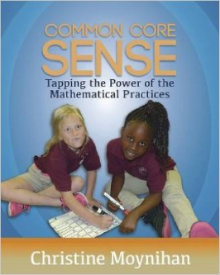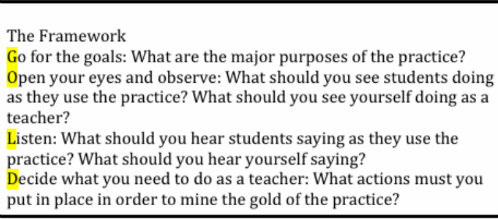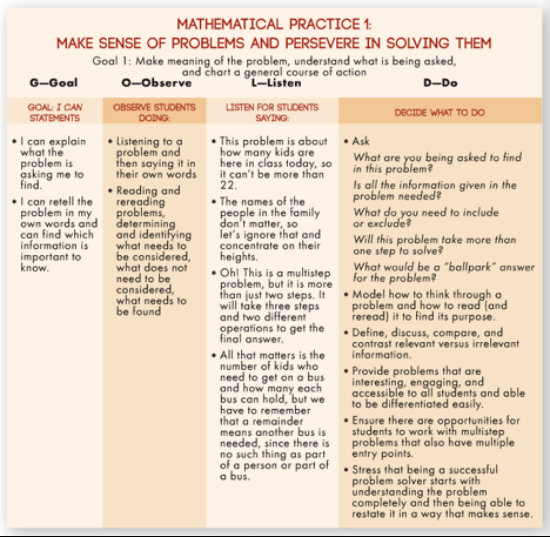Beyond “Unpacking” the Math Common Core
Common Core Sense: Tapping the Power of the Mathematical Practices
By Christine Moynihan
(Stenhouse, 2015 – Learn more)

What do “GOLD” and “Common Sense” have in common with the Common Core State Standards? According to Merriam Webster, common sense is about exercising “sound and prudent judgment based on a simple perception of the situation or facts”. Gold is a yellow precious metal…valued especially for use in jewelry and decoration, and to guarantee the value of currencies.”
Christine Moynihan’s new book, Common Core Sense: Tapping the Power of the Mathematical Practices, is a piece of gold that helps teachers in grades 4-5 “unpack” the standards in a way that makes sense, using “common sense.”

Christine Moynihan, a former classroom teacher, mathematics curriculum specialist, and elementary school principal, has created the GOLD framework to help teachers break apart each of the Common Core Mathematical Practices. She knows how daunting the task is to “unpack and understand the standards” She knows from her own experience that teachers need time and sustained support… that not every district is able to provide that sustained support, even with the best of intentions…that any change of this magnitude is difficult.
Change can be an awkward business
This is the first book that I had to “stand up for” — ready to cheer and ready to do the following exercise that explains why change is difficult. She did an excellent job of explaining change. You try it!
Stand up where you are, cross your arms over the front of your body and then reverse the way in which you have crossed your arms. Now, reflect on what it took to do it and how it felt. Think about the steps you took each time. Did you feel uncomfortable? Challenged? Awkward? That’s fine. Change does not happen because we will it to happen. We need to remember that change “is a process and not an event.” (If you are a math coach, professional development provider, teacher leader, or curriculum director, this is a great activity to try with your group.)
For years, teachers have been saying that students need to be more proficient at problem solving. We also recognize that students need to try solving problems in more than one way and take a chance. Don’t be afraid if you don’t get it the first time or you make a mistake. The first time I saw “IDK” on a student’s paper, I was more than confused. I was baffled until I realized that it meant “I don’t know.”
As much as we try to set a classroom environment where students are not afraid to take a chance or make a mistake, they still may be reluctant to make that venture into the unknown. As I read Ms. Moynihan’s book, I knew that I had an ally. She would be my mentor, my guide, my confidante, my partner on the adventure to help my students explore the unknown universe of math.
Why I like this book
There are many reasons why I enjoyed reading this book. First, it is real: real teachers, real examples, real student reflections. Each chapter shows how the practice should look and sound like in classrooms and how to take the steps to “move to GOLD” (supporting the incorporation and implementation of the Mathematical Practices into daily practice.). The GOLD framework gives the teacher a chance to outline his or her own thinking.
I love the student work samples, class vignettes, and teacher reflection pieces within each chapter. Each chapter features one of the eight Mathematical Practices, while the final chapter provides suggestions on how to move forward in your own classroom. Moynihan provides simple-to-grasp-and-apply suggestions, either for the teacher to use individually with students or with a collaborative study group.
In addition, within each chapter she identifies the major goals that are related to the focused practice. For example: the three major goals of the Mathematical Practice “Look for and make use of structure” are to:
- identify and describe numeric and geometric patterns and use their structure to make predictions and hypotheses
- use perspective to consider the whole of something as well as to identify components of the whole
- apply prior knowledge and structural understanding to new problem situations
Perfect for book study & teacher collaboration
I would recommend using this book within a Professional Learning Community. We tell our students that one of the 21st century skills is to work together collaboratively. We need to do it as well. We see the chain reaction when collaborating students brainstorm or turn and talk in the classroom. The excitement builds. Using this book in your PLC gives you a chance to review and reflect on your mathematical practices in the classroom and to re-invigorate your practices.
It’s not always easy to locate books about math practice that aren’t workbooks or based solely in theory and numbers. This book is an excellent choice for teachers to read, practice within their classrooms, and reflect with their peers, especially since Stenhouse has provided a free Study Guide on their website.
Whether you plan to use this book as an independent study, as part of a professional learning community, or as a book club selection, you will find it easy to apply in the classroom, relevant, and an excellent companion in your professional library.
Linda Biondi is a fourth grade teacher at Pond Road Middle School in Robbinsville, NJ, and a long-time Morning Meeting practitioner. She’s also the recipient of several educational grants, a Teacher Consultant with the National Writing Project and a participant on the NJ Department of Education Teacher Advisory Panel. Linda participates in ECET2 Celebrate Teaching which has posted an interview with her.



































